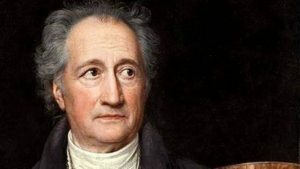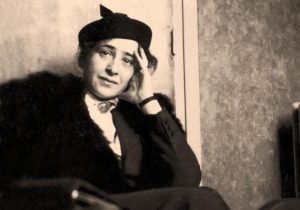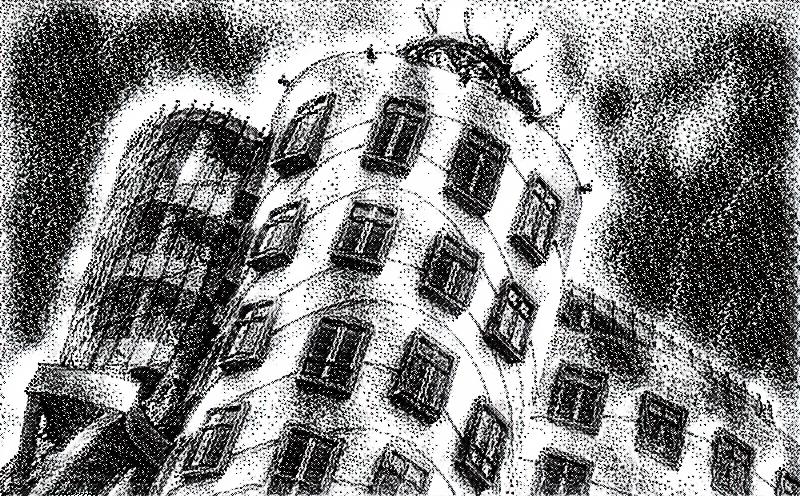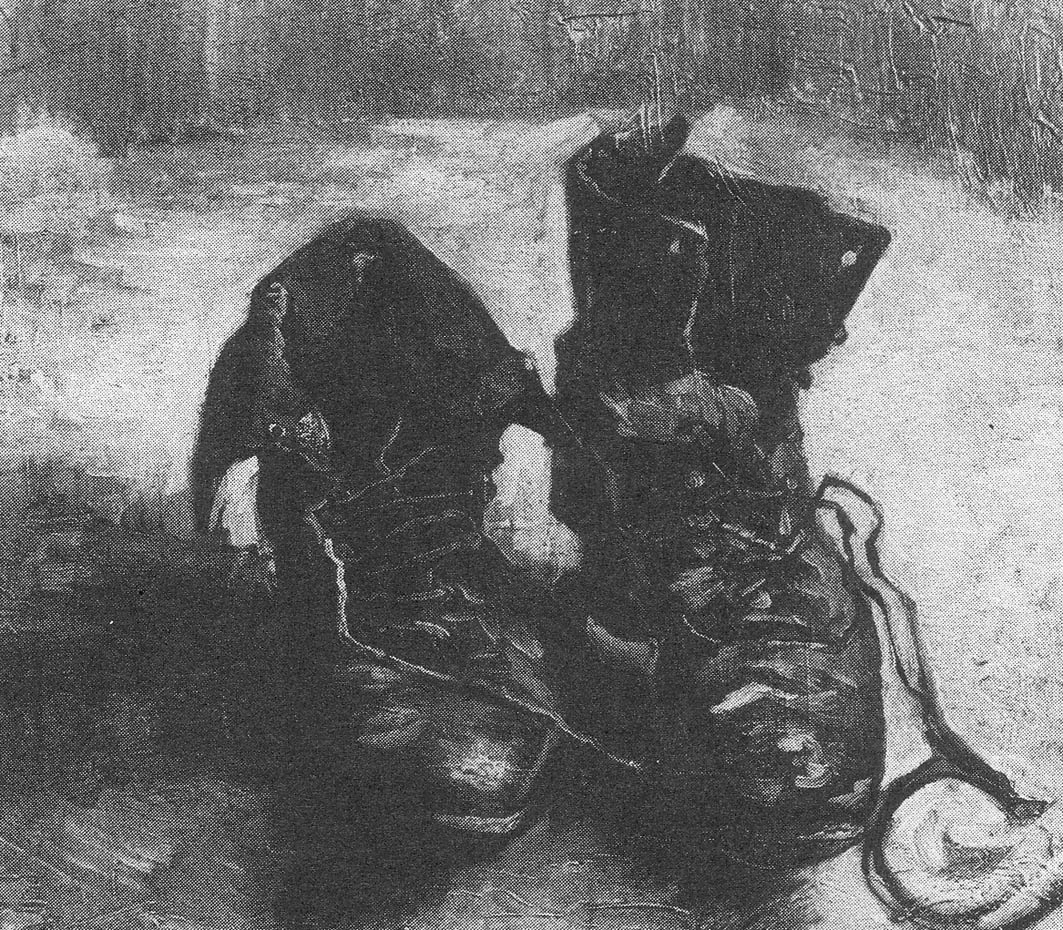The following is the second of a two-part series. The first segment was published on July 25, 2016 and can be accessed here.
Another Finitude – Rosenzweig versus Heidegger
Thus, even if not completely in accord with Heidegger” “letter,” Blanchot’s deconstructive reading allows to see the shadow thrown by his thanatic ‘spirit”: in Derrida’s words, death, instead of forming Dasein’s “most proper possibility,” can turn into an absolute aporia: “the most improper possibility and the most ex-propriating, the most inauthenticating one.”[1]
This aporetic tendency is precisely the reason why Rosenzweig’s project appears more promising. It liberates the notion of positive finitude from the dubious supremacy of death and focuses instead on love. This instead is the clue of the whole operation: while love bears some affinities to death, it also brings an irreducible difference. While it may be as indefinite as the Blanchotian “dying,” it is also “hard as Sheol,” which protects it from dissolving into abyssal and measureless “unreality”; it may not have a well-defined essence, but it remains in its open indefiniteness, and does not slide back into “nothingness” or “nullity.”
As such, love works better as the “mobilizing” factor in the conditions of finitude; instead of sealing the finite life with the non-negotiable arrêt, which, as Blanchot had demonstrated, is always its latent potency, love actually offers an “opening” in the form of an affective mood that opens “access” to as many beings as possible, knowing that there will be no infinite time given for their contemplation. Thus, if finitude exerts a pressure on the subject who then simply must make a decision, this “narrowing” expresses itself better in the decisionism of love.[2]
We could thus sum up the confrontation between Heidegger and Rosenzweig on the issue of finite life and the role of death in approaching the finitude, by stating: while for Heidegger, the role of death will always be central – whether as the “mobilizing” factor of Entschlossenheit or the “appeasing” factor of Gelassenheit – for Rosenzweig, to the contrary, it will always be downplayed, almost to the point of indifference.[3] This confrontation never took place in reality, but we can try to stage it as follows.
First, Heidegger. In the series of lectures composed in 1935 and then edited under the title Introduction to Metaphysics, Heidegger only confirms Blanchot’s suspicion as to the aporetic nature of death within his system. Here, he openly presents death as the ultimate aporia, by drawing on the original Greek meaning of the word as “no way-out,” “no exit,” the unsurpassable “blocking of the passage.” Man, who likes to see himself as pantoporos, the most resourceful creature which “begets in itself its own un-essence, the versatility (Vielwendigkeit) of many twists and turns,”[4] deep down appears to be, in fact, aporos: a priori blocked and thwarted –
There is only one thing against which all violence-doing [of the pantoporos hubristic human Dasein] directly shatters. That is death. It is an end beyond all completion, a limit beyond all limits. Here there is no breaking forth and breaking up, no capturing and subjugating. But this un-canny thing, which sets us simply and suddenly out from everything homely once and for all, is not a special event that must also be mentioned among others, because it, too, ultimately does occur. The human being has no way out in the face of death, not only when it is time to die, but constantly and essentially. Insofar as humans are, the stand in the no-exit of death (IM, 168-9; my emphasis).
For Rosenzweig, just like for Heidegger, human life is with no pre-established essence: indefinite, open, question-like. The latter, in the Introduction to Metaphysics, states firmly that “the determination of the essence of the human being is never an answer, but is essentially a question” (IM, 149). Yet, the two thinkers play it out very differently.

Heidegger, as we have already seen, nolens volens gravitates towards the closure, the seal, the dead-assuredness of death, which then substitutes for the missing essence of the Dasein: Seinsdenken and Todesdenken become in the end indistinguishable synonyms. It is, after all, death which tears away man from the familiar homeliness of the world of seeming and throws him in the nearness of Being, the most un-canny – un-heimlich – of all thoughts. It is the annihilating, nichtende, power of death, which puts man in touch with the Nichts des Seins, the nothingness of Being’s pure potentiality, which underlies the realm of actualised beings.
Death, therefore, becomes the vehicle of the highest spiritual transport which defines the destiny of human Dasein. The human being has no way out in the face of death, not only when it is time to die, but constantly and essentially; this, for Rosenzweig, is precisely the sickness – “sickness unto death” – which pushes death into the very centre of human life, as its defining moment, giving it constancy and essence. In Heidegger, no being, no positive content can ever fill the gap of nothingness which constitutes human being and thus offer an answer to its glaring questioning abyss; this Nichts can only be matched by the Nichts of death which helps to disclose the abyssal Nichts of Being.
Rosenzweig’s intention is precisely to counteract the mastery of this deadly triad which turns the ordinary “un-essence” of human life into a hypostatised sublime “Nothing.” In order to avoid this hypostasis, the life must agree to be the thing of “un-essence,” a flow without form, a meandering story with many twists and turns: a “life which is content to be an in-between state, merely a transition from one thing to another” (USH, 80).
Rosenzweig explores the essential Nichts of human life in the form of a horizontal narrative which evolves only thanks to its indefiniteness; by refusing to turn the singular life into something easily definable, he lets it assume a meandering structure, containing many peripeteias, the resourseful twists and turns, which postpone the final verdict; here the erzählendes Sprachdenken becomes a synonym of Lebensdenken, life-thinking.
As in Heidegger, the human life emerges here as open, indefinite, with no pregiven essence, but all this negative characteristic merely serves as the canvas for a new narrative philosophy, the new drama of time and its unpredictability, which can only evolve in the living dialogue between human being and his neighbours.
When commenting on affinities and divergences between Rosenzweig and Heidegger, Karl Löwith, who actually argues that they have much more in common than I want to claim, spots one crucial difference: while they both emphasize the Endlichkeit of human life, Heidegger dissolves it all in the immanent temporality, offering no resistance to transience, yet Rosenzweig insists on the infinite moment: the perfect fulfillment of life which truly and finally comes to be and thus eternalizes itself.[5]
True, but this eternal completion (which can never be attained by man, the self-contradicting pantoporos aporos, in Heidegger) is possible only on the grounds of the more fundamental form of infinity which plays itself out in human life, despite its finitude. We may call it in/de/finity or even infinitiveness (deriving from the grammatical concept of the infinitive which alludes to the potentially infinite uses into which the verb may be put): the peculiar condition of human life which refuses the be concrete ‘something” without actually slipping into a lethal “nothing” or the Blanchotian “unreality” –
…we must daringly seize upon a life which is content to be an in-between state, merely a transition from one thing to another. Let us reject the ever-present answer, “Life is,” “Man is – ” and let us become part of the onward-moving life of man. Here life “is” not, it simply occurs [geshieht] (USH, 80).
This is an outright apology of the inessential life: something very adversarial to Heidegger, who called it a wrong type of “un-essence,” superficial and resourceful as Odysseus (to whom this phrase originally refers) and as such incapable to plunge metaphysically into the abysses of Being.
But with this apology, we are immediately reminded that, in The Star of Redemption, this seemingly derogatory characteristic was given to what Rosenzweig regards as the highest and most valuable content of the revelation, that is, love. For it is love which goes from one neighbour to another and paces restlessly the whole world in the constant transition, oblivious to its own “essence” and not at all interested in the centering self-reflection.

It is love which, in Goethe’s words, “connects all” without creating a hypostatic Allheit, totality, itself indefinite and because of that infinitely open to embrace each being, one after another, nominally and nominalistically – just like God himself who knows every creature by name as a unique singularity.
For Rosenzweig, therefore, the life-in-transition, life-in-between, does not indicate dispersion, impurity or incompleteness, as it does for Heidegger: it is inessential so it can fill itself with intense neighborly relations; it is lacking essence, so it can be full of love.
As Jean-Luc Nancy puts it in his Finite Thinking, in the fragment inspired more by Rosenzweig than Heidegger: “Love cuts across finitude, always from the other to the other, which never returns to the same – and all loves, so humbly alike, are superbly singular. Love offers finitude in its truth; it is finitude’s dazzling presentation.”[6]
We could thus sum up the difference between Rosenzweig and Heidegger by evoking the biblical line, which is also the guiding motif of The Star: azzah hamavet ahavah, love strong as death. The vital, incomplete, exposed in/de/finity of love versus the definite closure, sealed by the verdict of death. Both these visions of life are finite, but while the Heideggerian one overestimates the defining moment of the ending as “constant and essential,” the Rosenzweigian one evades it as merely secondary, because Rosenzweig is not looking for any definition of human life.
Agreeing that human life must remain a “thing of un-essence,” he rather goes for love which thrives on everything non-essential: strictly singular, transitory, non-identitarian, exposed. Here, human being is not a death-bound “nothing,” collapsing into his inner nothingness, but a lively bundle of energy which easily flows into “the energies of the world” (USH, 92). Love turns the negativity of “un-essence” into positivity of intense singular relation. This is what Rosenzweig calls die Umkehr: the “turn,” but also, more theologically – a “conversion.”
In the Beginning is My End – Arendt, Bloom, and the Finitude of Origins
There seems to be no much love in philosophy: in Hegel, Rosenzweig’s main adversary, as well as in Heidegger, the later enemy of Levinas, human finite life is spent under the solitary auspices of death. Jean-Luc Nancy, who follows the analytics of Dasein only to a certain point, knows it well and for this very reason enlists for his “finite thinking” another ally, coming from the corner opposite to Heidegger – Hannah Arendt.
As he rightly points out, Arendt is the first thinker to consciously and deliberately move away from Heidegger without regressing into an idealistic illusion of the Husserlian “transcendental life”: the first thinker to elaborate a parallel project of another finitude which does not exclude infinity but transposes it into the original plurality of love relations, “the infinite singularity among others.”
Thus, in the footnote explaining the idea of his essay, Being Singular Plural, Nancy announces that his “finite thinking” is not going to be just a commentary on Heidegger but also a “move on from him”: “in the relation to Heidegger, one must remember the singular role played by Hannah Arendt and her reflection on “human plurality”.”[7] This singular role comes to the fore most spectacularly in Hannah Arendt’s doctoral dissertation, Augustins Liebesbegriff, “On the Concept of Love in Saint Augustine,” written in the 20’s under Martin Heidegger’s supervision.
The first part of Arendt’s dissertation is devoted to the critique of Augustine’s idea of love which, in her interpretation, turns our to be a Thanatos in disguise: it is hard not to see that this is, in fact, a veiled critique of Heidegger himself. Arendt shows how Augustine, caught in the terminological net of Neoplatonic thought, which defines love as craving (appetitus), runs into trouble with his account of the concept coming from a different tradition: the neighbourly love (caritas).
Augustine’s thinking is thus wholly inscribed into a metaphysical craving for the eternal and the infinite, which completely disregards the finite dimension of the creaturely life. In the passage which strongly reminds of Blanchot’s analogical take on Heidegger, Arendt states that for Augustine, “life on earth is a living death, mors vitalis, or vita mortalis. It is altogether determined by death; indeed it is more properly called death.”[8]
But then, she also detects another stream of thought in Augustine – less “Greek” and more “Paulian” – which connects love not with the Platonic lack of being and craving, but with a fulness of being as given by the Maker in the moment of man’s birth. Says Arendt:
The decisive fact determining man as a conscious, remembering being is birth or “natality,” that is, the fact that we have entered the world through birth. The decisive fact determining man as a desiring being was death or mortality, the fact that we shall leave the world in death. Fear of death and inadequacy of life are the springs of desire.
In contrast, gratitude for life having been given at all is the spring of remembrance, for a life is cherished even in misery: “Now you are miserable and still you do not want to die for no other reason that you want to be.” What ultimately stills the fear of death is not hope or desire, but remembrance and gratitude: “Give thanks for wanting to be as you are that you may be delivered from an existence that you do not want. For you are willing to be and unwilling to be miserable.” This will to be under all circumstances is the hallmark of man’s attachment to the transmundane source of his existence (LA, 52).
It is precisely in this context that Augustine draws his distinction between principium and initium: the beginning of the world and time and the beginning of man. Arendt quotes the famous fragment from The City of God (XII, 20): Initium ut esset, creatus est homo, ante quem nemo fuit: “That a beginning be made, man was created.” Whereas principium grounds the universe in the manner of the Greek arche, i.e. as the first arch-principle of perpetual order of being, initium allows for a creative disruption of the cosmic monotony, into which there suddenly enters a novitas, something radically new.

But what is the role of remembrance and gratitude as opposed to hope and desire? Arendt attempts an alternative anthropology of human finitude, based not so much on the Heideggerian, thanatic recognition of one’s inevitable end-in-death, as on the biophilic, life-loving recognition of one’s beginning-in-birth, here understood as the “gift-of-life.” The finite being does not have to think about itself as “running towards its death”; it can also think about its moment of springing into being, its “whence,” where it was bestowed with life, and revert the sequence of expectation by substituting the beginning for the end; or, in other words, by eliminating the obsessive thinking-of-death and replacing it with the contemplating remembrance of one’s origin.
The Augustinian man says: I want to return where I came from; In my beginning is my proper end: the promised fullness of life. Remembrance and gratitude, therefore, are not strictly opposed to hope and desire; rather they engender their own structure of hope and desire, this time not driven by the recognition of death, but by the wish to cherish the original gift of life, to intensify it, to hope for “more life” yet to come –
Since our expectations and desires are prompted by what we remember and guided by a previous knowledge, it is memory and not expectation (for instance, the expectation of death as in Heidegger’s approach) that gives unity and wholeness to human existence […] Only man, but no other mortal being, lives toward his ultimate origin while living toward the final boundary of death […] By virtue of man”e quest for his own being, the beginning and end of his life become exchangeable (LA, 56-57; my emphasis).
It is this fundamental reversal which makes human finite existence truly human: Arendt’s notion of exchangeability between the beginning and the end, structurally resembles the Rosenzweigian Umkehr where love, given by the Maker, replaces death, sealing the creaturely existence with the heavy mark of mortality (given the fact that Arendt knew The Star of Redemption at the time when she wrote about Augustine, her natalism may in fact be derivative from Rosenzweig’s existential lesson on the “conversion”).
We will find some later variants of this reversal in other thinkers inspired by the Jewish heritage. In Levinas, it is precisely this reversed temporality which creates a counter-current against death, a human life as Sein-gegen-Tode; instead of running straight towards its end, the human life creates an “eddy,” or an “interiority,” in the stream of time, which resists the flow of transience, and by reaching freely towards its origins in memory, it separates itself from being’s general participation in the flux, thus making itself free.[9]
Poising himself against Heidegger even more explicitly, Harold Bloom argues that the poetic life (which for him serves as the intensified pars pro toto of human life as such) is structured according to the rhetorical trope of metalepsis or the “reversal”: the substitution of an origin for an end, which allows for the emancipation of a creative impulse from the thanatic repetition of “more of the same.”
Only when cause and effect are metaleptically reversed and the poetic self, instead of going with the flow “unto-death,” works stubbornly towards his own origins, a new creation can happen at all; only when the poet dwells within and elaborates on the powers of origination, can he hope to become truly original, not just a copy or replica of what was before. The Arendtian-Levinasian-Bloomian focus on the origins is thus the necessary precondition of freedom, creativity, and (why not) “resoluteness,” which, in Nietzsche’s words, rebel against the time’s “It was,” that is, against the time’s empty accumulation and repetition.[10]
This is where, as it seems, Hegel, Heidegger, and Kojève, the three masters of modern thanaticism, get it wrong: it is not just the consciousness of death, which acts as an anthropogenic factor which makes human being truly human. A mere consciousness of death only adds a reflexive dimension to the animal way of living, which inevitably ends with dying; as indeed in Hegel’s description of the Master who once challenged death fully consciously but then leads an idle life of a verblödet, stupefied, beast.
What truly constitutes the anthropogenic moment is the reversal of temporality, which ignores the end for the sake of the doubled origin: the renewal of the gift of being. For Paul and Augustine, due to this reversal-renewal, death as such completely dissolves by showing its true face of a rebirth into a truly eternal way of living. But this is only an extreme, Christian, version of the anthropogenic reversal, which goes as far as to annul altogether the initial condition of finitude; by turning death simply into a new birth, this time giving life eternal and infinite, the Christian “impatient heart” (Rosenzweig) evacuates itself from the realm of creatureliness, inescapably marked with death.
What Arendt, but also Rosenzweig, Levinas and Bloom, have in mind is more modest, and more in harmony with the finite being: the reversal does not prolong the moment of “natality” ad infinitum, offering a birth without death and life without loss, but complicates the temporality of human finite existence by giving it a non-natural, or reverse, causa finalis. It lets human origin shine on and organise the whole of life by de-privileging the natural end.
Contrary to the thanatic condition, which indeed overestimates death as the ownmost, organizing and defining, goal-center-essence of human life, this vision of finitude, focused on natality, ignores the natural end by replacing it with the counter-rhythm of a constant renewal, working on and through the original “gift of life”: a gift not be defined and pinned down to its “essence,” but to be shared and diffused, as a “thing of un-essence,” in intense relation with others.
Thus, the very idea of the gift itself immediately implies sociality inherent in the moment of origin – versus the absence of others, obliterated in the solitary (unbezüglich) moment of dying, so often emphasized and extolled by Heidegger. The focus on the beginning of human life, rather than on its end, brings in the original heterogeny of human existence: the constant company of others who gave me life and sustained its precarious growth with their love, the company summarised in the ideal image of the Augustinian “God, who made me.”
Seen from the perspective of its beginning, the finite human life is immediately dialogic – while seen from the perspective of its end it sinks into the soliloquy of death, always too jemeinig and einzigst to be shared.[11]
This is Arendt’s major piece de resistance against Heidegger’s influence: a resistance demonstrating an elective affinity with the one offered first, half-unknowingly by Rosenzweig, and then, already fully deliberately by Levinas and Bloom. Their new affirmation of finite life, which can be put collectively under the Rosenzweigian heading of New Thinking, takes roots in the united anti-Heideggerian impulse which manages to mobilize latent reserves of alternative vitalistic traditions, among which the Jewish heritage with its imperative “choose life!” is certainly not to be ignored.
Far from being obedient “Heidegger’s children,” Rosenzweig, Arendt and Bloom offer instead a promise of a different thinking which is not fated with the Heideggerian thanatic closure and as such still full of an unexplored future potential.
Agata Bielek-Robson is Professor of Jewish Studies at the University of Nottingham. She is the author among many works of Judaism in Contemporary Thought: Traces and Influence (Routledge, 2014); Jewish Cryptotheologies of Late Modernity: Philosophical Marranos (Routledge, 2014) and The Saving Lie: Harold Bloom and Deconstruction (Northwestern University Press, 2011).
__________________________________________________
[1] Derrida, Aporias, p. 77.
[2] This alternative form of “resoluteness,” playing itself out in Rosenzweig, was well spotted by Levinas: “What interests Rosenzweig himself is the discovery of being as life, of being as life-in-relation: the discovery of a thought which is the very life of this being. The person no longer goes back into the system he conceives, as in Hegel, in order to become fixed and renounce his singularity. Singularity is necessary to the exercise of this thought and this life precisely as an irreplaceable singularity, the only one capable of love, the only one that can be loved, that knows how to love, that can form a religious community”: Emmanuel Levinas, “Between Two Worlds (The Way of Franz Rosenzweig),” in Difficult Freedom, trans. Sean Hand, Baltimore: The Johns Hopkins University Press, 1997, p. 192.
[3] To the possible objection that I tend to conflate here two completely different visions of death – before and after the “turn” – I can only answer that, to me, they are not that different. In both cases, the issue of death is dominant because it allows access to the highest truth of Being: before it is the “throwness” of an isolated Dasein; after it is the totality of Being as “the side of life averted from us” where “death and the realm of the dead belong to the whole of beings as its other side.” Still systematically overestimated, death merely changes the function: before it individuated Dasein, after it negates all separation, by reconciling us with the hidden holistic aspect of Being. See Martin Heidegger, “What Are Poets For?,” in Poetry, Language, Thought, trans. A. Hofstadter, New York: Harper and Row, 1971, p. 125. In what follows I quote Heidegger’s Introduction to Metaphysics which, written in 1935, offers a perfect example of the passage from the pre-turn to the post-turn stage in his thought.
[4] Martin Heidegger, Introduction to Metaphysics, trans. Gregory Fried and Richard Polt, Yale University Press: New Haven, 2000, p. 168. Later in the text as IM.
[5] See Karl Löwith, “M. Heidegger and F. Rosenzweig. Or Temporality and Eternity,” in Philosophy and Phenomenological Research, vol. 3, nr 1 (Sept. 1942).
[6] Nancy, A Finite Thinking, p. 264; my emphasis.
[7] Nancy, Being Singular Plural, p. 194.
[8] Hannah Arendt, Love and Saint Augustine, trans. Joanna Vecchiarelli Scott and Judith Chelius Stark, Chicago & London: The University of Chicago Press, 1996, p. 11. Later in the text as LA.
[9] See most of all Emmanuel Levinas” openly anti-Heideggerian discussion on death in Totality and Infinity, where he defends human life’s own dimension of delaying death: “This is why the life between birth and death is neither folly nor absurdity nor flight nor cowardice. It flows on in a dimension of its own where it has meaning, and where the triumph over death can have meaning” (Emmanuel Levinas, Totality and Infinity. An Essay on Exteriority, trans. Alphonso Lingis, Dordrecht: Kluver Academic Publishers 1991, p. 56). And further: “The postponement of death in a mortal will – time – is the mode of existence and reality of a separated being that has entered in the relation with the Other. This space of time has to be taken as the point of departure. In it is enacted a meaningful life which one must not measure against the ideal of eternity, taking its duration and its interests to be absurd or illusory” (ibid., 232). In Levinas, human life is consciously finite, not aspiring to eternity, yet its finitude is not determined solely by mortality, but also by a resistance against death, drawn from the sources of memory which pulls against the time’s seemingly irreversible “it was.” His vision of the triumph over death (ultimately exercised in the love of the neighbour) remains strictly within the confines of the finite life.
[10] The natalistic structure of reversal or metalepsis allows for the fruitful “revenge against time,” that is, precisely for what Nietzsche deemed absolutely impossible: “Willing liberates; but what is it that puts even the liberator himself in fetters? “It was”—that is the name of the will’s gnashing of teeth and most secret melancholy. Powerless against what has been done, he is an angry spectator of all that is past. The will cannot will backwards; and that he cannot break time and time’s covetousness, that is the will’s loneliest melancholy… This, indeed this alone, is what revenge is: the will’s resentment against time and time’s “it was””; Friedrich Nietzsche, Thus Spake Zarathustra, trans. Thomas Common, New York: Modern Library 1917, p. 53; my emphasis. For Nietzsche, the only way of “willing backwards” is the consensual and conciliatory so wollte Ich: “To redeem those who lived in the past and to recreate all “it was” into a “thus I willed it”—that alone should I call redemption“ (ibid.). But for Bloom, who bases his whole system on his polemic with Nietzsche, such resignation of will in face of time’s transience would never do. In The Anxiety of Influence, he defines creativity as a combination of repetition and memory, where the latter is always a remembrance of one’s origins, pulling against the temporal flow: “Creativity is thus always the mode of repetition and of memory and also of what Nietzsche called the will’s revenge against time and against time’s statement of “It was.””; Harold Bloom, The Anxiety of Influence, p. 98.
[11] However, Arendt never properly developed her theme of natality, though it remained one of her most frequent “thought trains”; see Scott and Stark, the editors of the Augustine thesis, in their essay “Rediscovering Hannah Arendt,” LA, p. 147. Scott and Stark enumerate all the instances of Arendt’s return to the theme of natality. First, in “What Is Freedom?” from 1960 (reprinted in Between Past and Future 1977, p. 167): “Because he is a beginning, man can begin; to be human and to be free are one and the same. God created man in order to introduce into the world the faculty of beginning: freedom.” The same line is repeated almost verbatim in The Origins of Totalitarianism (p. 479), where she persistently (though perhaps not fully consistently with her own chosen Greek idiom, dominating her thought from Human Condition onwards) uses theological terminology and calls such outbursts of freedom “miracles.” And finally in The Life of the Mind, vol. 2, Willing: “This very capacity for beginning is rooted in natality, and by no means in creativity, not in a gift but in a fact that human begins, new men, again and again appear in the world by virtue of birth” (p. 217) (in LA, pp. 147-148). But Arendt never explains how it actually happens. Whereas it is, in fact, far from obvious. For, how from the general fact that we all are born in the same way can there spring something truly new and fresh? Arendt never addresses this question, but it is a starting point for Harold Bloom, the master of paradoxes inevitably issuing from his general theory of individual creativity: how is it that the same initial conditions, resulting in the same psychogenic strategies, can eventually produce something truly new? It is not enough to be born and know about it; it is also a question of a peculiar working-through of this awareness, which is the main theme of Bloom’s interpretation of the Freudian family romance.




